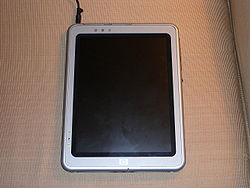
TC1100
Encyclopedia


Tablet computer
A tablet computer, or simply tablet, is a complete mobile computer, larger than a mobile phone or personal digital assistant, integrated into a flat touch screen and primarily operated by touching the screen...
sold by Hewlett-Packard
Hewlett-Packard
Hewlett-Packard Company or HP is an American multinational information technology corporation headquartered in Palo Alto, California, USA that provides products, technologies, softwares, solutions and services to consumers, small- and medium-sized businesses and large enterprises, including...
that was the follow-up to the Compaq TC1000
Compaq TC1000
The TC1000 is a hybrid Tablet PC designed by Compaq, before it was purchased by HP. It used the Transmeta Crusoe processor. Unlike many Tablet PCs which can only operate either in traditional laptop configuration, or with the keyboard folded behind the screen, the display is fully detachable from...
. The TC1100 had either an Intel Celeron or an Intel Pentium M chip set and could be upgraded to a maximum amount of 2 gigabytes of memory. These upgrades from the TC1000 were much welcomed after numerous complaints about the poor performance of the TC1000. The TC1100 was the last version from HP in this style of tablet. It was replaced by the HP Compaq TC4200
HP Compaq TC4200
The HP Compaq TC4200 is a Tablet PC that was released on March 1, 2005 and has since been discontinued. It is believed to be the successor to the TC1100, which was discontinued in Q4 of 2005. The TC4200 boasted many powerful features that could be found on mid to high-range laptops and competing...
, which featured a more traditional non-detachable design.
Design
The TC1100 has a 10.4 inch LCD display and pressure-sensitive penWacom
in Krefeld, Germany. Wacom is a Japanese portmanteau: Wa for "harmony" or "circle", and Komu for "computer". Wacom tablets are notable for their use of a patented cordless, battery-free, and pressure-sensitive stylus or digital pen...
that shares the same basic design as its predecessor, the TC1000. It has a unique design that has been coined by many as a hybrid tablet
Tablet computer
A tablet computer, or simply tablet, is a complete mobile computer, larger than a mobile phone or personal digital assistant, integrated into a flat touch screen and primarily operated by touching the screen...
. This refers to the fact that it has the properties of both a convertible and slate tablet. All the necessary hardware components are stored within the casing of the display and digitizer. This allows it to work with or without a keyboard attached. With the keyboard attached it can either be used in the same fashion as a laptop, with the keyboard supporting the rest of the tablet, or with the back of the tablet folded into the keyboard allowing the user to write on the screen easily. This sort of design gives much versatility and has gathered a cult-like following due to the lack of similar designs on the market.
The range of processors includes Pentium-M 1.0Ghz, 1.1Ghz, and 1.2Ghz. The high end TC1100 features the 1.2 GHz Intel Pentium M 753 Ultra Low Voltage processor(1.20 GHz, 2MB L2 cache, 400 MHz FSB), 60 GB hard drive, 512 MB (333 MHz) of installed RAM (2 GB max), 54g wi-fi connectivity (802.11b/g), Bluetooth wireless connectivity, Secure Digital memory card slot, and Windows XP Tablet PC Edition operating system.
The TC1100 allows for easy access to its memory, hard drive, and wireless card. The memory comes standard as either 256MB or 512MB and can be upgraded to 2GB. The hard drive is also easily upgradeable, most 2.5-inch IDE hard drives are compatible with it but the tablet will only address up to 137GB due to a lack of LBA48 support. The wireless card can be accessed from the same area as the memory, but some tablets that did not originally have a wireless card installed may not have the antenna installed either making a new installation either hard or impossible.
HP implemented 6 customizable controls: 3 physical buttons along the side of the unit, and 3 stylus-sensitive spots in the bezel of the display. In addition, there is a "jog dial" in line with the physical buttons, which can be used for scrolling or zooming, as controlled by software.
Two small retractable "feet" were also included on the back on the tablet, allowing for an angled writing surface when extended, and ventilation when placed on a flat surface.
Discontinued
By the end of 2005, HP had discontinued the TC1100. It retained a loyal following, however, due to its uncommon design. HP's official response to questions asked about the TC1100's discontinuation is that "HP remains committed to the Tablet PC platform".TX1000 Series
Since discontinuing the TC1100, HP has released a new line of tablets, the TX1100US and the TX1200US being the first of the line. These updated versions are substantially more powerful than the TC series, but are of the more conventional convertibleTablet computer
A tablet computer, or simply tablet, is a complete mobile computer, larger than a mobile phone or personal digital assistant, integrated into a flat touch screen and primarily operated by touching the screen...
design.

